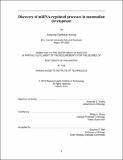| dc.contributor.advisor | Phillip A. Sharp. | en_US |
| dc.contributor.author | Young, Amanda Garfinkel | en_US |
| dc.contributor.other | Massachusetts Institute of Technology. Dept. of Biology. | en_US |
| dc.date.accessioned | 2010-08-26T15:29:00Z | |
| dc.date.available | 2010-08-26T15:29:00Z | |
| dc.date.copyright | 2010 | en_US |
| dc.date.issued | 2010 | en_US |
| dc.identifier.uri | http://hdl.handle.net/1721.1/57565 | |
| dc.description | Thesis (Ph. D.)--Massachusetts Institute of Technology, Dept. of Biology, 2010. | en_US |
| dc.description | This electronic version was submitted by the student author. The certified thesis is available in the Institute Archives and Special Collections. | en_US |
| dc.description | Cataloged from student submitted PDF version of thesis. | en_US |
| dc.description | Includes bibliographical references (p. 217-239). | en_US |
| dc.description.abstract | The genomes of plants and animals encode hundreds of non-coding ~22nt RNAs termed "microRNAs" (miRNAs). These RNAs guide the sequence-specific inhibition of translation and destabilization of mRNA targets through short (6-7 nucleotide) stretches of complementarity between the 5' end of the miRNA (seed region) and the 3' untranslated region (UTR) of the targeted mRNA. Computational estimates based on prediction of conserved seed matches in 3'UTRs suggest that over half of genes in mammalian genomes are miRNA-regulated. Many miRNAs are also ubiquitously expressed in a variety of embryonic and adult tissues. Given these observations, we have sought to address the challenge of determining which cellular and biological processes that miRNAs might regulate in different cell types and tissues. First, we have developed methods to isolate candidate miRNA-targeted mRNAs by immunoprecipitation of Ago2 in the miRNA effector complex (miRNP). In one purification method, the Ago2-bound mRNAs are identified by microarray. The second purification method adds crosslinking, RNase digestion, and cloning and deep-sequencing (CLIP-seq) to improve the specificity. These experiments were performed in mouse embryonic stem cells (mESCs) and a miRNA-deficient derivative cell line, lacking miRNA-processing enzyme, Dicer, to enrich for targets of miR-290~295, a miRNA cluster highly-expressed in mESCs. By these methods, we have identified a set of candidate mRNAs that bear a motif in their 3'UTRs that matches the seed of miR-290~295 and exhibit a miRNA-dependent gene expression signature. Gene ontology analysis of these candidate mRNAs shows they are involved in regulating the cell cycle, apoptosis, and the TGF-[beta] pathway. We further show that mESCs lacking miR-290~295 are unable to differentiate into endoderm, a TGF-[beta] regulated process. We present additional evidence that RNAs crosslinked to Ago2 are significantly enriched in a G-rich motif in a miRNA-independent manner, as it is present in Ago2-CLIP libraries from Dicer wild-type and Dicer null mESCs. This G-rich motif exhibits higher conservation than the general 3'UTR background and appears to modulate the activity of miR-290~295 binding sites from the 3'UTRs of two genes. This G-rich motif may confer additional specificity to the AgomiRNP and increase its affinity for miRNA-targeted mRNAs. We have also investigated the function of a family of miRNA clusters in mouse embryonic development by targeted deletion of miR-17~92, and its paralogs, miR-106b~25 and miR-106a~363. miR-106b~25 and miR-106a~363 null mice are viable and fertile, however, miR- 17~92-null mice die short after birth with lung hypoplasia and ventral septal defect. miR-17~92 null embryos also lack mature B cells, due to a block in the pro- to pre-B cell transition. Pre-B cells from the fetal livers of miR-17~92 null embryos have higher rate of apoptosis compared to wild-type embryos and upregulation of pro-apoptotic gene, Bim, a miR-17~92 target. Our findings demonstrate roles for two different clusters of miRNAs in regulating cellular processes of cell cycle, cell death, and cell signaling, that are important for differentiation of several different tissue types. Biochemical target identification and targeted deletion of miRNA clusters in the mouse are both useful tools for uncovering miRNA functions. | en_US |
| dc.description.statementofresponsibility | by Amanda Garfinkel Young. | en_US |
| dc.format.extent | 242 p. | en_US |
| dc.language.iso | eng | en_US |
| dc.publisher | Massachusetts Institute of Technology | en_US |
| dc.rights | M.I.T. theses are protected by
copyright. They may be viewed from this source for any purpose, but
reproduction or distribution in any format is prohibited without written
permission. See provided URL for inquiries about permission. | en_US |
| dc.rights.uri | http://dspace.mit.edu/handle/1721.1/7582 | en_US |
| dc.subject | Biology. | en_US |
| dc.title | Discovery of miRNA-regulated processes in mammalian development | en_US |
| dc.type | Thesis | en_US |
| dc.description.degree | Ph.D. | en_US |
| dc.contributor.department | Massachusetts Institute of Technology. Department of Biology | |
| dc.identifier.oclc | 654432545 | en_US |

